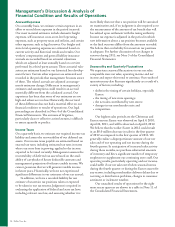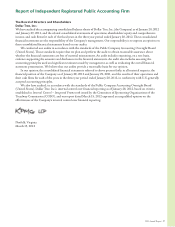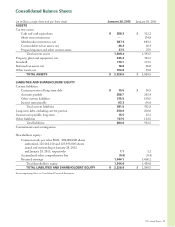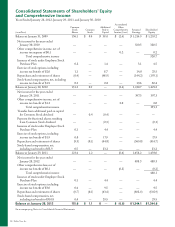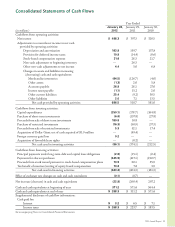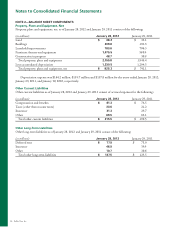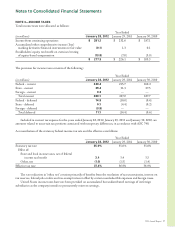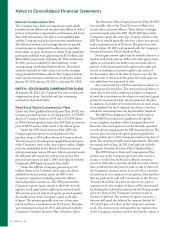Dollar Tree 2011 Annual Report Download - page 36
Download and view the complete annual report
Please find page 36 of the 2011 Dollar Tree annual report below. You can navigate through the pages in the report by either clicking on the pages listed below, or by using the keyword search tool below to find specific information within the annual report.
1RWHVWR&RQVROLGDWHG)LQDQFLDO6WDWHPHQWV
Financial Instruments
e Company utilizes derivative financial instruments
to reduce its exposure to market risks from changes
in interest rates and diesel fuel costs. By entering into
receive-variable, pay-fixed interest rate and diesel fuel
swaps, the Company limits its exposure to changes
in variable interest rates and diesel fuel prices. e
Company is exposed to credit-related losses in the event
of non-performance by the counterparty to these instru-
ments but minimizes this risk by entering into transac-
tions with high quality counterparties. Interest rate or
diesel fuel cost differentials paid or received on the swaps
are recognized as adjustments to interest and freight
expense, respectively, in the period earned or incurred.
e Company formally documents all hedging relation-
ships, if applicable, and assesses hedge effectiveness both
at inception and on an ongoing basis. e interest rate
swaps that qualified for hedge accounting are recorded
at fair value in the accompanying consolidated balance
sheets as a component of “other liabilities”. Changes in
the fair value of these interest rate swaps are recorded
in “accumulated other comprehensive income (loss)”,
net of tax, in the accompanying consolidated balance
sheets. e Company entered into diesel fuel swaps that
do not qualify for hedge accounting. e fair values of
these diesel fuel swaps are recorded in the accompanying
consolidated balance sheets as a component of “other
current assets”.
Fair Value Measurements
Fair value is defined as an exit price, representing the
amount that would be received to sell an asset or paid
to transfer a liability in an orderly transaction between
market participants. As such, fair value is a market-
based measurement that should be determined based
on assumptions that market participants would use in
pricing an asset or liability. As a basis for considering
such assumptions, a fair value hierarchy has been
established that prioritizes the inputs used to measure
fair value. e hierarchy gives the highest priority to
unadjusted quoted prices in active markets for identical
assets or liabilities (Level 1 measurement) and the lowest
priority to unobservable inputs (Level 3 measurements).
e three levels of the fair value hierarchy are as follows:
Level 1 – Quoted prices in active markets for identical
assets or liabilities;
Level 2 – Quoted prices for similar instruments in active
markets; quoted prices for identical or similar
instruments in markets that are not active; and
Level 3 – Unobservable inputs in which there is little or
no market data which require the reporting
entity to develop its own assumptions.
e Company’s cash and cash equivalents, restricted
investments and diesel fuel swaps represent the financial
assets and liabilities that were accounted for at fair value
as of January 28, 2012. As required, financial assets
and liabilities are classified in their entirety based on
the lowest level of input that is significant to the fair
value measurement. e Company’s assessment of
the significance of a particular input to the fair value
measurement requires judgment, and may affect the
valuation of fair value assets and liabilities and their
placement within the fair value hierarchy levels. e fair
value of the Company’s cash and cash equivalents and
restricted investments was $288.3 million and $83.6
million, respectively at January 28, 2012. ese fair
values were determined using Level 1 measurements in
the fair value hierarchy. e fair value of the diesel fuel
swaps was an asset of $0.6 million as of January 28, 2012.
e fair values of the swaps were estimated using Level 2
measurements in the fair value hierarchy. ese estimates
used discounted cash flow calculations based upon
forward interest-rate yield and diesel cost curves. e
curves were obtained from independent pricing services
reflecting broker market quotes.
e carrying value of the Company’s long-term debt
approximates its fair value because the debt’s interest rate
varies with market interest rates.
Certain assets and liabilities are measured at fair
value on a nonrecurring basis; that is, the assets and
liabilities are not measured at fair value on an ongoing
basis but are subject to fair value adjustments in certain
circumstances (e.g., when there is evidence of impair-
ment). e Company recorded an impairment charge
of $0.9 million in fiscal 2011 to reduce certain store
assets to their estimated fair value. e fair values were
determined based on the income approach, in which the
Company utilized internal cash flow projections over the
life of the underlying lease agreements discounted based
on a risk-free rate of return. ese measures of fair value,
and related inputs, are considered a Level 3 approach
under the fair value hierarchy. ere were no other
changes related to Level 3 assets.
34 Dollar Tree, Inc.


